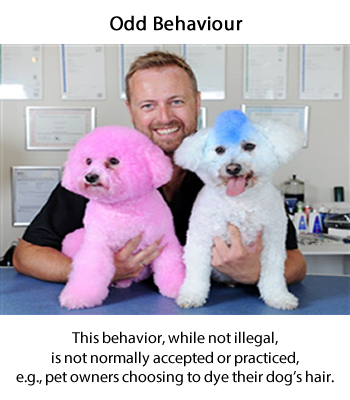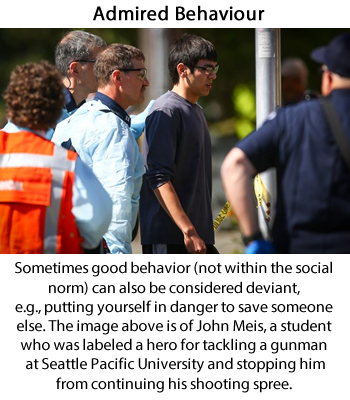Social Patterns and Trends
Deviance
MINDS ON
“
To be yourself in a world that is constantly trying to make you something else is the greatest accomplishment.
~ Ralph Waldo Emerson
Around the world and throughout history, societies and cultural groups have various behavioural expectations of their members. When people act in accordance with these expectations, they are conforming to the norms(definition:Behaviour considered normal.) of that group. However, not everyone chooses to conform to the norms at all times.
Deviance is defined as behavior which departs from the socially accepted norm. There are many different actions that can be considered deviant by an individual. As always, however, there is strength in numbers. When a group of people are acting in a deviant but similar way, a subculture(definition:A small subset of people within a larger group who have something in common.) is formed which is able to define its own behavioural norms.

Why are so many people fascinated with deviant behavior? In fact, it has become a common theme in pop culture. A number of reality television shows are based upon behavior that could be considered deviant by some - "The Maury Show" and The Real Housewives series are a few examples.
Take a moment to determine what YOU consider to be deviant behavior.
Deviant
ACTION
Types of Deviance
There are a number of different types of deviance. Click through the slideshow below to find a description.
These ideas are reinforced in the following video. As you watch, consider the different formal and informal rules for behaviour that you see in your daily life.
There are also a number of sociological theories that attempt to explain different aspects of deviance – both why it occurs and how it is perceived. Below, you will find three different theories and corresponding questions to consider. As you read these theories, you should also think about whether they can only be applied to Bad Behaviour, Odd Behaviour, or Admired Behaviour.
Theories
It is important to remember that acts cannot be classified as deviant in any standard way. The classification is specific to the:
- situation;
- time period;
- culture;
- personal viewpoints of the participants; and/or their
- frequency of behaviour. Primary Deviance occurs when a person occasionally breaks a norm (such as underage drinking only at parties), whereas an act of secondary deviance occurs when people behave in deviant ways regularly (such as career criminals).
Revisit the list of actions at the start of this lesson and consider how your parents might identify deviant behaviour. How would a friend define it? Would you disagree with them with regard to any of these actions?
To further ‘illustrate' this point, the video below looks at tattoos at different times in history in different geographic locations and societies.
It wasn't very long ago in Ontario that tattoos were mainly associated with those involved in criminal activities, military service, or cultural traditions. Recently, however, tattoos have moved from a subculture to claim a place in pop culture, as this article explains.
Did you know that some current trends include inner lip and tongue tattoos, glow-in-the-dark tattoos and temporary freckle tattoos? Do any of these seem more or less deviant than more ‘traditional' tattoos? Is anything still ‘off limits' in the world of tattoos? These choices may not be seen as being deviant in an individual's personal life. However, would they be viewed differently in a professional context?
While criminal deviance will be discussed in detail in the next lesson, positive deviance or admired behaviour is also often represented in the media. Take, for instance, men who choose to support women's rights, pay equity, and gender parity(definition:Equal access to education.) Many male celebrities, and even Justin Trudeau, are publically calling themselves feminists in order to help support this important social change campaign. Does the addition of famous voices to this conversation help to further this cause? Why or why not?
Defining Behaviour Norms and Deviance
We have codes of behavior in our lives that are written or explicitly stated (movie theatres, school codes of conduct, work expectations) and those that are unwritten (first dates, fancy restaurants), but neither of these categories guarantee that expected behavior will always be followed.
 Codes of Behaviour
Codes of Behaviour
Every school has expectations for the behavior of its students, including post-secondary institutions. Every workplace has behavioral expectations for its employees.
That does not, however, mean that those expectations are followed.
Please find a copy of the code of behavior for your current (or previous) school, for your workplace, or for another institution of your choice, and compare it to the behavior that you actually observe in that building.
Identify each of the following:
- a section of the code of conduct that you have noticed is not being adhered to;
- what you believe to be the goal of that section of the code of conduct;
- the behavior that you have noticed in the building regarding this section of the code of conduct; and
- why you believe the code is not followed.
In your opinion, should the portion of the code of conduct stay, be altered, or be removed from the document? Explain your response.
Consequences
Deviance and Social Change
Deviance can come about accidentally, but it can also be purposeful. Either of these situations has the potential to be a mechanism of social change. Sometimes, deviant behavior is purposely encouraged in order to make a point.
In other instances, deviance involves more serious events such as protests or illegal actions designed to gain attention and to create awareness. The question at the beginning of this lesson asks if deviant behavior serves a purpose in society. Social change is often a result of people refusing to accept or act out social norms. Consider the Montreal graffiti artist, Roadsworth, or the recent protests at the economic summit in Toronto. Do these deviant behaviours serve a purpose in society?


